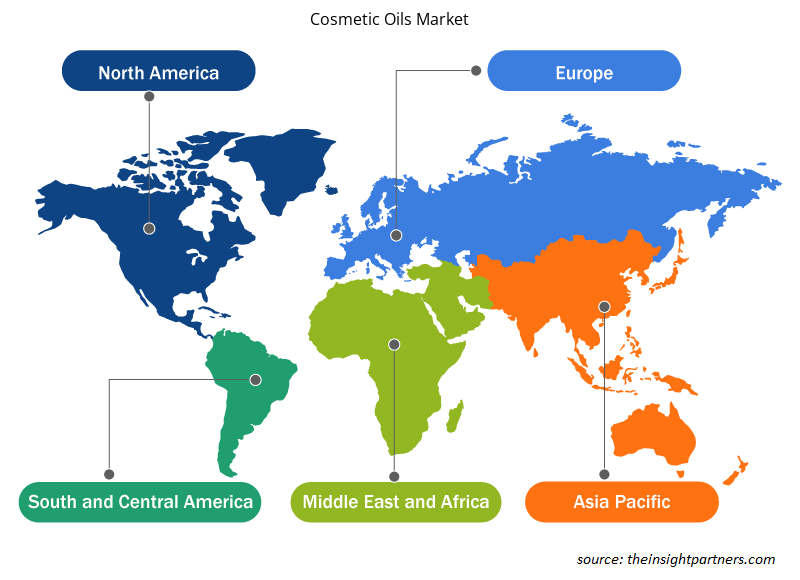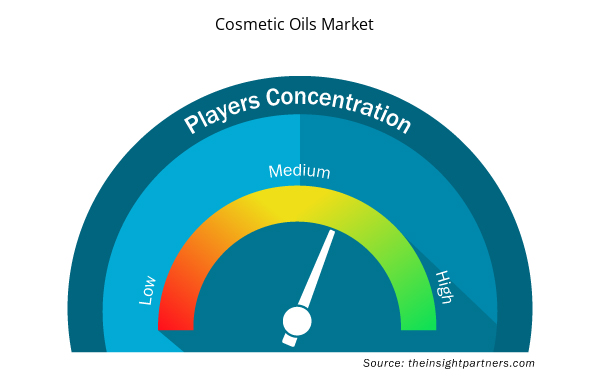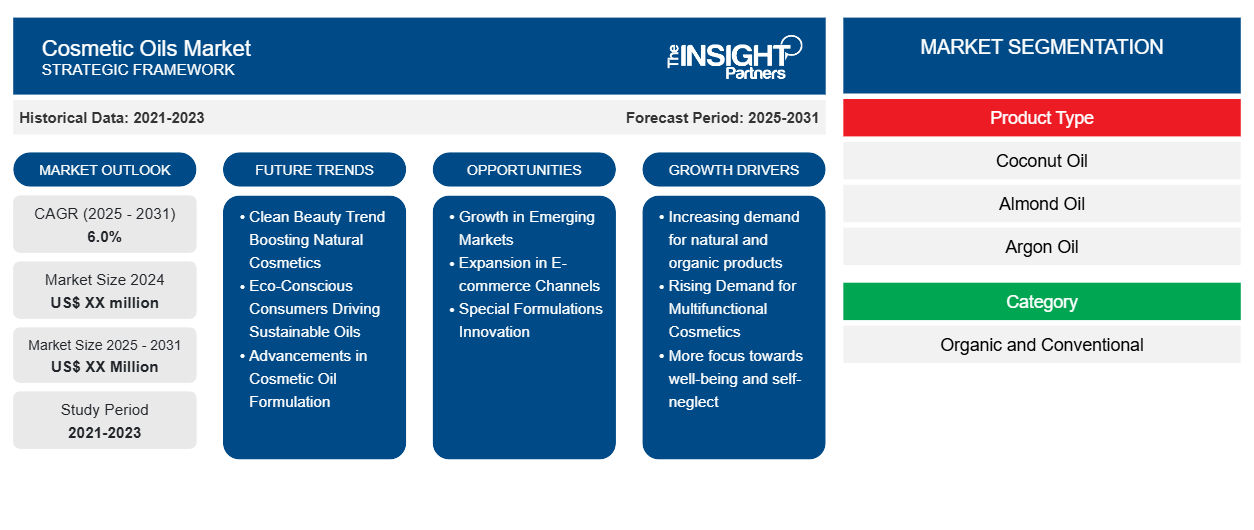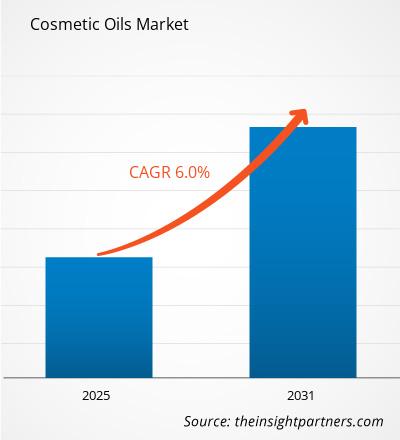Der Markt für kosmetische Öle wird voraussichtlich von 2024 bis 2031 eine durchschnittliche jährliche Wachstumsrate (CAGR) von 6,0 % verzeichnen, wobei die Marktgröße von XX Millionen US-Dollar im Jahr 2024 auf XX Millionen US-Dollar bis 2031 wachsen wird.
Der Markt für kosmetische Öle ist nach Produkttyp, Kategorie, Vertriebskanälen und Geografie segmentiert. Basierend auf dem Produkttyp ist der Markt in Kokosnussöl, Mandelöl, Arganöl, Teebaumöl, Jojobaöl und andere segmentiert. Basierend auf der Kategorie ist der Markt in Bio und konventionell segmentiert. Basierend auf dem Vertriebskanal ist der Markt in Supermärkte und Hypermärkte, Convenience Stores, Online-Einzelhandel und andere segmentiert. Der Berichtsumfang umfasst fünf Regionen: Nordamerika, Europa, Asien-Pazifik, Naher Osten und Afrika sowie Süd- und Mittelamerika und Schlüsselländer in jeder Region. Die globale Analyse ist weiter auf regionaler Ebene und in den wichtigsten Ländern aufgeschlüsselt. Der Bericht bietet den Wert in USD für die oben genannte Analyse und Segmente.
Zweck des Berichts
Der Bericht „Markt für kosmetische Öle“ von The Insight Partners soll die aktuelle Situation und das zukünftige Wachstum sowie die wichtigsten treibenden Faktoren, Herausforderungen und Chancen beschreiben. Dies wird verschiedenen Geschäftspartnern Einblicke geben, wie zum Beispiel:
- Technologieanbieter/-hersteller: Um die sich entwickelnde Marktdynamik zu verstehen und die potenziellen Wachstumschancen zu kennen, damit sie fundierte strategische Entscheidungen treffen können.
- Investoren: Durchführung einer umfassenden Trendanalyse hinsichtlich der Marktwachstumsrate, der finanziellen Marktprognosen und der Chancen entlang der Wertschöpfungskette.
- Regulierungsbehörden: Zur Regulierung von Richtlinien und Überwachungsaktivitäten auf dem Markt mit dem Ziel, Missbrauch zu minimieren, das Vertrauen der Anleger zu bewahren und die Integrität und Stabilität des Marktes aufrechtzuerhalten.
Kosmetische Öle Marktsegmentierung
Produkttyp
- Kokosnussöl
- Mandelöl
- Argonöl
- Teebaumöl
- Jojobaöl
Kategorie
- Bio und konventionell
Vertriebskanal
- Supermärkte und Hypermärkte
- Convenience-Stores
- Online-Einzelhandel
Geographie
- Nordamerika
- Europa
- Asien-Pazifik
- Süd- und Mittelamerika
- Naher Osten und Afrika
Passen Sie diesen Bericht Ihren Anforderungen an
Sie erhalten kostenlos individuelle Anpassungen an jedem Bericht, einschließlich Teilen dieses Berichts oder einer Analyse auf Länderebene, eines Excel-Datenpakets sowie tolle Angebote und Rabatte für Start-ups und Universitäten.
- Holen Sie sich die wichtigsten Markttrends aus diesem Bericht.Dieses KOSTENLOSE Beispiel umfasst eine Datenanalyse von Markttrends bis hin zu Schätzungen und Prognosen.
Wachstumstreiber auf dem Markt für kosmetische Öle
- Steigende Nachfrage nach natürlichen und biologischen Produkten: Die Nachfrage nach Kosmetika steigt erheblich, da sich die Verbraucher zunehmend der Vorteile von Kosmetikprodukten mit natürlichen und biologischen Inhaltsstoffen bewusst werden. Die meisten Verbraucher achten heute auf die Inhaltsstoffe ihrer Schönheitsprodukte und suchen nach Rezepturen, die frei von schädlichen Chemikalien sind. Dies hat zu einer weiteren Steigerung der Nachfrage nach natürlichen Ölen wie Jojoba-, Argan- und Kokosöl geführt, die wegen ihrer pflegenden Eigenschaften und Hautverträglichkeit beliebt sind.
- Steigende Nachfrage nach multifunktionalen Kosmetika: Die Nachfrage nach multifunktionalen Kosmetikprodukten steigt stark an, da Verbraucher Produkte bevorzugen, die mehr als eine Funktion haben. Kosmetische Öle fallen ebenfalls leicht in diesen Trend, da sie für verschiedene Zwecke verwendet werden können, darunter als Kosmetik für die Haut- oder Haarpflege und sogar als Make-up. Diese Vielseitigkeit macht sie äußerst attraktiv und fördert daher ihre Verwendung in einer breiten Palette von Kosmetikformulierungen.
- Mehr Fokus auf Wohlbefinden und Selbstvernachlässigung: Mit der zunehmenden Bedeutung von Wellness und Selbstpflege werden die Kaufgewohnheiten der Verbraucher langsam auch in der Kosmetikindustrie von diesem Trend beeinflusst. Verbraucher wollen nicht nur gut aussehen, sondern sich auch gut fühlen. Kosmetische Öle, die als beruhigend und therapeutisch gelten, würden die Aufmerksamkeit von Verbrauchern erregen, die sich selbst pflegen möchten.
Zukünftige Trends auf dem Markt für kosmetische Öle
- Clean-Beauty-Trend stärkt Naturkosmetik: Die Clean-Beauty-Bewegung hat an Fahrt gewonnen und sich als sehr profitabel erwiesen, da die Verbraucher bei allen verwendeten Produkten Sicherheit, Ungiftigkeit und Umweltfreundlichkeit fordern. Infolgedessen verlassen sich Marken in ihren Rezepturen viel stärker auf natürliche und organische Öle und achten noch mehr auf Transparenz bei der Beschaffung der Inhaltsstoffe. Diese wachsende Nachfrage nach Clean Beauty zwingt die Hersteller dazu, die Reinheit und Nachhaltigkeit ihrer kosmetischen Öle in den Mittelpunkt zu rücken.
- Umweltbewusste Verbraucher setzen auf nachhaltige Öle: Da umweltbewusste Verbraucher zunehmend in nachhaltig und ethisch einwandfrei gewonnene Kosmetiköle investieren, müssen die Marken verantwortungsbewusst einkaufen, um die Nachhaltigkeit der Inhaltsstoffe und den Nutzen für die lokale Gemeinschaft sicherzustellen. Das funktioniert gut und kommt bei umweltbewussten Verbrauchern gut an. Daher treibt es die Nachfrage nach Produkten an, die diesen Werten gerecht werden, die sie mit ihrer Wahl verbinden.
- Fortschritte bei der Formulierung kosmetischer Öle: Kosmetische Öle können dank Fortschritten in der Extraktions- und Formulierungstechnologie, die ihre Stabilität verbessern, möglicherweise besser extrahiert und formuliert werden. Techniken wie Kaltpressung und überkritische CO2-Extraktion ermöglichen die maximale Wirksamkeit natürlicher Öle. Gleichzeitig können Verkapselungstechnologien den Herstellern weitere Möglichkeiten bieten, die Abgabe und Aufnahme von Wirkstoffen in Ölformulierungen zu verbessern, was das Interesse der Verbraucher weiter weckt.
Marktchancen für kosmetische Öle
- Wachstum in Schwellenmärkten: Die Wachstumschancen in Schwellenmärkten liegen in den Schwellenmärkten im asiatisch-pazifischen Raum, in Lateinamerika und Afrika. Höhere Einkommen und deren Zuteilung zum verfügbaren Einkommen führen zu einer stärkeren Urbanisierung und verändern die Schönheitsstandards, die einen Bedarf an Kosmetikprodukten, einschließlich Ölen, schaffen. Marken können nun auf die bevorzugten regionalspezifischen Produkte zurückgreifen und sich an die Kultur und Vorlieben der jeweiligen Region anpassen.
- Ausbau der E-Commerce-Kanäle: Dieses rasante Wachstum im E-Commerce bietet Kosmetikölmarken hervorragende Möglichkeiten, eine größere Bevölkerungsgruppe zu erreichen. Online ist eine Komplettlösung, bei der Verbraucher eine große Produktpalette sehen und sich für die Lieferung nach Hause entscheiden können. Für Marken kann dies auch hilfreich sein, in digitales Marketing zu investieren, um ihre Kosmetiköle effizient zu bewerben, indem sie diesen wachsenden Appetit auf Online-Beauty-Shopping ausnutzen.
- Innovation bei Spezialformeln: Es gibt einen enormen Spielraum für Spezialformeln in den Bereichen Alterung, Feuchtigkeitsversorgung und empfindliche Haut. Marken können die Möglichkeit nutzen, einzigartige Öl- und Wirkstoffmischungen zu kombinieren, um individuellere Produkte zu entwickeln, die sich auf bestimmte Probleme beziehen, einen größeren Kundenkreis ansprechen und so die Markenaffinität stärken.
Regionale Einblicke in den Markt für kosmetische Öle
Die regionalen Trends und Faktoren, die den Markt für kosmetische Öle im Prognosezeitraum beeinflussen, wurden von den Analysten von Insight Partners ausführlich erläutert. In diesem Abschnitt werden auch die Marktsegmente und die Geografie für kosmetische Öle in Nordamerika, Europa, im asiatisch-pazifischen Raum, im Nahen Osten und Afrika sowie in Süd- und Mittelamerika erörtert.

- Holen Sie sich die regionalen Daten für den Markt für kosmetische Öle
Umfang des Marktberichts über kosmetische Öle
| Berichtsattribut | Details |
|---|---|
| Marktgröße im Jahr 2024 | XX Millionen US-Dollar |
| Marktgröße bis 2031 | XX Millionen US-Dollar |
| Globale CAGR (2025 - 2031) | 6,0 % |
| Historische Daten | 2021-2023 |
| Prognosezeitraum | 2025–2031 |
| Abgedeckte Segmente | Nach Produkttyp
|
| Abgedeckte Regionen und Länder | Nordamerika
|
| Marktführer und wichtige Unternehmensprofile |
|
Dichte der Marktteilnehmer für kosmetische Öle: Die Auswirkungen auf die Geschäftsdynamik verstehen
Der Markt für kosmetische Öle wächst rasant, angetrieben durch die steigende Nachfrage der Endverbraucher aufgrund von Faktoren wie sich entwickelnden Verbraucherpräferenzen, technologischen Fortschritten und einem größeren Bewusstsein für die Vorteile des Produkts. Mit steigender Nachfrage erweitern Unternehmen ihr Angebot, entwickeln Innovationen, um die Bedürfnisse der Verbraucher zu erfüllen, und nutzen neue Trends, was das Marktwachstum weiter ankurbelt.
Die Marktteilnehmerdichte bezieht sich auf die Verteilung der Firmen oder Unternehmen, die in einem bestimmten Markt oder einer bestimmten Branche tätig sind. Sie gibt an, wie viele Wettbewerber (Marktteilnehmer) in einem bestimmten Marktraum im Verhältnis zu seiner Größe oder seinem gesamten Marktwert präsent sind.
Die wichtigsten auf dem Markt für kosmetische Öle tätigen Unternehmen sind:
- SOPHIM IBERIA SL
- Maverik-Öle
- RENKERT ÖL
- Lebermuth, Inc
- OLVEA Pflanzenöle
Haftungsausschluss : Die oben aufgeführten Unternehmen sind nicht in einer bestimmten Reihenfolge aufgeführt.

- Überblick über die wichtigsten Akteure auf dem Markt für kosmetische Öle
Wichtige Verkaufsargumente
- Umfassende Abdeckung: Der Bericht deckt die Analyse von Produkten, Dienstleistungen, Typen und Endbenutzern des Marktes für kosmetische Öle umfassend ab und bietet einen ganzheitlichen Überblick.
- Expertenanalyse: Der Bericht basiert auf dem umfassenden Verständnis von Branchenexperten und Analysten.
- Aktuelle Informationen: Der Bericht stellt durch die Abdeckung aktueller Informationen und Datentrends Geschäftsrelevanz sicher.
- Anpassungsoptionen: Dieser Bericht kann angepasst werden, um spezifische Kundenanforderungen zu erfüllen und die Geschäftsstrategien optimal anzupassen.
Der Forschungsbericht zum Markt für kosmetische Öle kann daher dabei helfen, die Branchensituation und Wachstumsaussichten zu entschlüsseln und zu verstehen. Obwohl es einige berechtigte Bedenken geben kann, überwiegen die allgemeinen Vorteile dieses Berichts tendenziell die Nachteile.
- Historische Analyse (2 Jahre), Basisjahr, Prognose (7 Jahre) mit CAGR
- PEST- und SWOT-Analyse
- Marktgröße Wert/Volumen – Global, Regional, Land
- Branche und Wettbewerbsumfeld
- Excel-Datensatz



Report Coverage
Revenue forecast, Company Analysis, Industry landscape, Growth factors, and Trends

Segment Covered
This text is related
to segments covered.

Regional Scope
North America, Europe, Asia Pacific, Middle East & Africa, South & Central America

Country Scope
This text is related
to country scope.
Häufig gestellte Fragen
Rise of clean beauty products in products is expected to be the key market trend.
The report can be delivered in PDF/Word format, we can also share excel data sheet based on request.
On the basis of geography, the cosmetic oils market is classified into North America, Europe, Asia Pacific, Middle East and Africa, and South and Central America
L'Oréal Paris, Mielle Organics LLC, UNITE Eurotherapy, Inc, Burt's Bees, Martínez Nieto, S.A, Uncle Harry's Natural Products, Le Prunier, DERMA E, SOWÉ Botanic Lab, and SKY ORGANICS are some of the players operating in the market.
The major factors driving the cosmetic oils market are:
1.Growing Demand for Natural and Organic Products
2. Rising Popularity of Multi-functional Products
The Cosmetic Oils Market is estimated to witness a CAGR of 6.0% from 2023 to 2031
Trends and growth analysis reports related to Chemicals and Materials : READ MORE..
The Insight Partners performs research in 4 major stages: Data Collection & Secondary Research, Primary Research, Data Analysis and Data Triangulation & Final Review.
- Data Collection and Secondary Research:
As a market research and consulting firm operating from a decade, we have published and advised several client across the globe. First step for any study will start with an assessment of currently available data and insights from existing reports. Further, historical and current market information is collected from Investor Presentations, Annual Reports, SEC Filings, etc., and other information related to company’s performance and market positioning are gathered from Paid Databases (Factiva, Hoovers, and Reuters) and various other publications available in public domain.
Several associations trade associates, technical forums, institutes, societies and organization are accessed to gain technical as well as market related insights through their publications such as research papers, blogs and press releases related to the studies are referred to get cues about the market. Further, white papers, journals, magazines, and other news articles published in last 3 years are scrutinized and analyzed to understand the current market trends.
- Primary Research:
The primarily interview analysis comprise of data obtained from industry participants interview and answers to survey questions gathered by in-house primary team.
For primary research, interviews are conducted with industry experts/CEOs/Marketing Managers/VPs/Subject Matter Experts from both demand and supply side to get a 360-degree view of the market. The primary team conducts several interviews based on the complexity of the markets to understand the various market trends and dynamics which makes research more credible and precise.
A typical research interview fulfils the following functions:
- Provides first-hand information on the market size, market trends, growth trends, competitive landscape, and outlook
- Validates and strengthens in-house secondary research findings
- Develops the analysis team’s expertise and market understanding
Primary research involves email interactions and telephone interviews for each market, category, segment, and sub-segment across geographies. The participants who typically take part in such a process include, but are not limited to:
- Industry participants: VPs, business development managers, market intelligence managers and national sales managers
- Outside experts: Valuation experts, research analysts and key opinion leaders specializing in the electronics and semiconductor industry.
Below is the breakup of our primary respondents by company, designation, and region:

Once we receive the confirmation from primary research sources or primary respondents, we finalize the base year market estimation and forecast the data as per the macroeconomic and microeconomic factors assessed during data collection.
- Data Analysis:
Once data is validated through both secondary as well as primary respondents, we finalize the market estimations by hypothesis formulation and factor analysis at regional and country level.
- Macro-Economic Factor Analysis:
We analyse macroeconomic indicators such the gross domestic product (GDP), increase in the demand for goods and services across industries, technological advancement, regional economic growth, governmental policies, the influence of COVID-19, PEST analysis, and other aspects. This analysis aids in setting benchmarks for various nations/regions and approximating market splits. Additionally, the general trend of the aforementioned components aid in determining the market's development possibilities.
- Country Level Data:
Various factors that are especially aligned to the country are taken into account to determine the market size for a certain area and country, including the presence of vendors, such as headquarters and offices, the country's GDP, demand patterns, and industry growth. To comprehend the market dynamics for the nation, a number of growth variables, inhibitors, application areas, and current market trends are researched. The aforementioned elements aid in determining the country's overall market's growth potential.
- Company Profile:
The “Table of Contents” is formulated by listing and analyzing more than 25 - 30 companies operating in the market ecosystem across geographies. However, we profile only 10 companies as a standard practice in our syndicate reports. These 10 companies comprise leading, emerging, and regional players. Nonetheless, our analysis is not restricted to the 10 listed companies, we also analyze other companies present in the market to develop a holistic view and understand the prevailing trends. The “Company Profiles” section in the report covers key facts, business description, products & services, financial information, SWOT analysis, and key developments. The financial information presented is extracted from the annual reports and official documents of the publicly listed companies. Upon collecting the information for the sections of respective companies, we verify them via various primary sources and then compile the data in respective company profiles. The company level information helps us in deriving the base number as well as in forecasting the market size.
- Developing Base Number:
Aggregation of sales statistics (2020-2022) and macro-economic factor, and other secondary and primary research insights are utilized to arrive at base number and related market shares for 2022. The data gaps are identified in this step and relevant market data is analyzed, collected from paid primary interviews or databases. On finalizing the base year market size, forecasts are developed on the basis of macro-economic, industry and market growth factors and company level analysis.
- Data Triangulation and Final Review:
The market findings and base year market size calculations are validated from supply as well as demand side. Demand side validations are based on macro-economic factor analysis and benchmarks for respective regions and countries. In case of supply side validations, revenues of major companies are estimated (in case not available) based on industry benchmark, approximate number of employees, product portfolio, and primary interviews revenues are gathered. Further revenue from target product/service segment is assessed to avoid overshooting of market statistics. In case of heavy deviations between supply and demand side values, all thes steps are repeated to achieve synchronization.
We follow an iterative model, wherein we share our research findings with Subject Matter Experts (SME’s) and Key Opinion Leaders (KOLs) until consensus view of the market is not formulated – this model negates any drastic deviation in the opinions of experts. Only validated and universally acceptable research findings are quoted in our reports.
We have important check points that we use to validate our research findings – which we call – data triangulation, where we validate the information, we generate from secondary sources with primary interviews and then we re-validate with our internal data bases and Subject matter experts. This comprehensive model enables us to deliver high quality, reliable data in shortest possible time.


 Holen Sie sich ein kostenloses Muster für diesen Bericht
Holen Sie sich ein kostenloses Muster für diesen Bericht